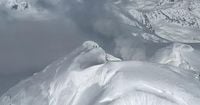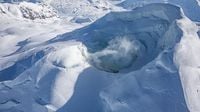As Mount Spurr, an 11,000-foot volcano located approximately 80 miles west of Anchorage, Alaska, shows signs of imminent eruption, over 300,000 residents are preparing for potential disaster. This once-quiet mountain has transformed into a focal point of concern as scientists detect escalating seismic activity and heightened volcanic gas levels.
Since early March, the Alaska Volcano Observatory (AVO) has reported a significant increase in earthquakes around the volcano, with 55 quakes recorded recently. These tremors, described as swarms of seismic activity, suggest that magma is rising beneath the surface, fracturing rocks as it moves upward. This alarming trend has led the AVO to maintain a yellow advisory level, indicating that an eruption could occur and urging nearby communities to prepare.
Matt Haney, the lead scientist at the AVO, stated, “Any eruption could shoot ash clouds up to 50,000 feet into the air.” Such an event could blanket Anchorage and surrounding areas in ash, reminiscent of the last eruption in 1992, which closed the city’s airport and coated it with an eighth of an inch of ash.
The seismic unrest has been building for some time. Earthquakes near Mount Spurr have surged from around 30 in March 2024 to 125 by October of that year. The US Geological Survey has logged hundreds of tremors in the vicinity, including a notable 3.7-magnitude quake near Petersville on April 2, 2025. Elevated levels of volcanic gases at the summit crater further indicate that the volcano is becoming increasingly active.
Residents in Anchorage are taking the warnings seriously. Many have begun gathering supplies such as masks, water jugs, and protective gear. The community is on high alert, readying itself for what could be a significant volcanic event. Local officials are urging residents to stay informed through official alerts from the AVO and other agencies monitoring the situation.
While the immediate risk to infrastructure is limited due to Mount Spurr's remote location, accessible only by chartered plane, the potential for disruption remains high. The fallout from an eruption could have far-reaching effects on daily life across south-central Alaska.
Volcanic eruptions are not just a concern for humans; they pose risks to wildlife, livestock, and agriculture as well. Volcanic ash, which forms when viscous magma erupts, can infiltrate the lungs of both people and animals, leading to respiratory issues and other health problems. The finest ash particles are particularly dangerous as they can penetrate deep into the lungs, potentially causing death by asphyxiation in severe cases.
Domestic pets and livestock are at risk, experiencing similar respiratory symptoms to humans. Ash exposure can cause distress, eye inflammation, and paw irritation in pets. For grazing animals, consuming volcanic ash can lead to severe health issues, including poisoned livestock and damaged teeth. During the 2010 Eyjafjallajökull eruption in Iceland, farmers were cautioned to shelter their sheep and cattle due to high fluoride concentrations in the ash.
The impact of volcanic ash extends beyond health concerns. It can significantly alter soil chemistry, introducing harmful elements such as arsenic and sulfur while also affecting crop viability. Ash can smother plants, block sunlight, and clog the stomata in leaves, preventing essential gas exchange. The aftermath of the 1991 Mount Pinatubo eruption in the Philippines serves as a stark reminder, as vast tracts of farmland became unproductive for years due to acidic ash deposits.
Moreover, volcanic ash can contaminate surface water, leaching toxins into groundwater and smothering aquatic ecosystems. The 2008 Chaitén eruption in Chile resulted in widespread fish deaths due to ash contamination in the Río Blanco.
Ash clouds pose a significant threat to aviation as well. When ash particles are ingested by aircraft engines, they can melt and clog fuel systems, leading to engine stalls. Historical incidents like British Airways Flight 9, which lost power in all four engines after encountering an ash cloud, highlight the dangers posed to air travel. In 2010, the Eyjafjallajökull eruption grounded over 100,000 flights across Europe, affecting millions of passengers and causing substantial economic losses.
As the situation at Mount Spurr evolves, residents are advised to remain indoors during ashfall events and wear N95 or P2 masks when venturing outside. Cloth masks provide insufficient protection against fine ash particles. It is also crucial to cover rainwater tanks and open wells to prevent contamination and to monitor livestock for signs of ash-related health issues.
In the face of potential disaster, rural communities that rely on agriculture and livestock are particularly vulnerable. Low-income households may lack access to clean water, protective gear, or safe shelter, making it essential for local governments to provide adequate resources and support.
Effective planning and public awareness are vital in mitigating the risks associated with volcanic eruptions. The International Volcanic Health Hazard Network offers guidelines for personal protection, emergency planning, and ash cleanup, which can help communities prepare for the worst.
As Mount Spurr continues to rumble, the long-term implications of volcanic ash remain a pressing concern. While the immediate dangers are clear, the potential for widespread disruption to health, agriculture, and infrastructure cannot be understated. Recognizing these risks and taking proactive measures will be crucial in safeguarding lives and livelihoods in the region.






